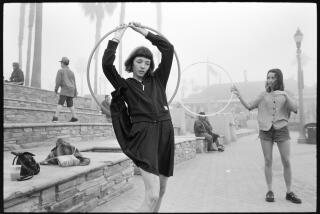Hobby That Blossomed : Dede Gilman’s intimate photographs of flowers and wildlife have brought her national recognition.
- Share via
A photograph: A snowy egret pauses in the Santa Barbara Bird Sanctuary, a lanky, white beacon in a misty landscape--except that the misty part is a superimposed photograph of clouds. This was one of 100 pictures chosen in 1992 by Outside magazine as the best photographs of the last 15 years and later included in the magazine’s book “Exposure.”
The photographer is Dede Gilman, best known for her clear, unmisty, intimate pictures of flowers and other wildlife. Gilman started taking pictures in 1981 as she hiked through the Newhall hills around her home. “I didn’t know what all the flowers were, and the nature center didn’t always know either, so I started taking natural history courses. The botany phase appealed to me. That led to doing flower hikes.” And eventually to national recognition for a career that grew out of a hobby.
We are outside Gilman’s home, sitting on a curved bench, one of many large sculptures on the property crafted by her husband, Richard, a retired biomedical engineer. We share the bench with three tall metal figures, their silvery heads bowed toward us. Beneath their gaze, Gilman and I look through her portfolio of vivid photos that have appeared in Sierra Club books and calendars, Pacific Horticulture magazine, Nature Conservancy News and several books that focus on Southern California native plants, including Kevin Connelly’s “Gardener’s Guide to California Wildflowers,” “Flowering Plants of the Santa Monica Mountains, Coastal & Chaparral Regions of Southern California” by Nancy Dale and “Oaks of California” by Bruce M. Pavlik, Pamela C. Muick, Sharon Johnson and Marjorie Popper.
“I always photograph in story line,” she says. “I take the habitat and things related to the flowers, almost like doing an environmental study.”
“Dede is that rare combination, a person with technical skills and great love and enthusiasm for the subject,” says author Connelly. “And underneath, she’s a very serene, very philosophical type of person, a good artist and photographer, but also a good teacher.”
Gilman was born in Arkansas, but she’s lived in Southern California for 40 years. “Seventeen years ago, when we moved here, this was really the country. Now,” she says, gesturing to a huge stucco apartment complex at the base of her hill, “it sure has changed.”
But she doesn’t dwell on the unhappy approach of civilization.
“I’m really lucky,” she says. “I get to do what I love and get paid for it.” She smiles. “I get to play with insects, flowers and snakes.” Pause. “I’ve been told I need professional help.” Then she laughs.
When Gilman goes off to play with flowers and snakes, she is weighted down with 30 pounds of equipment, including three cameras and a huge tripod.
“I use a one-to-one macro lens, sometimes extra diopters. Sometimes I reverse my lens so the back is to the flower instead of the front part. I use extension tubes. I even photograph some things through a microscope. I’ll bring something home, then return it to the wild. Once I found a brown stick with little flecks of gold on it. Under the microscope, I saw it was some little insect’s eggs. I decided to photograph it under the microscope and, as I was taking pictures, the eggs were hatching!”
In the field, she uses a kind of portable microscope--a hand lens. “You really see so much more: the little hairs, the pollen grains on the male flowers. My husband says, ‘Nothing has any privacy around you.’ ”
Not all of her photographs occur in a faraway wilderness.
She has rigged up a blind near her house, where she waits patiently (“The one thing you can’t do in a blind is read; you miss things”) for animals to cruise by. One time, she looked up and was startled. “My lens was full of spots. It was a bobcat. The light was so low I didn’t think the picture would work. Then her kitten showed up. I also saw a road runner one morning. He was hanging upside down from the top of the blind, looking at me.” She shakes her head, grinning at the memory.
“The easiest way to get pictures of animals is to know their habits. My strength is that I know what I photograph.”
In her studio, a big room with a corner fireplace, she has 3,000 bird photos, 8,000 to 10,000 flower pictures, plus mammals, snakes, insects, most of them in plastic holders in file drawers. “I will photograph anything that moves. Or doesn’t move,” she says.
Gilman almost never works on assignment; she goes where she wants, shoots what she likes, and then sells what she gets. Zion National Park is a favorite destination. “It’s such a special place, I sometimes think I can’t ever capture what I feel there.”
But most of all she loves to photograph the desert.
“Almost all parts--it’s always mysterious. It doesn’t present itself to you. You have to seek. In the harshest parts of the desert, things are so tiny you have to be on your knees.”
Her desert areas of choice are Joshua Tree, Anza-Borrego and Red Rock Canyon. Although she will be in Mendocino in May and then Montana, she has set aside three weeks for Arizona next year.
“I always try to be available for the desert,” she says.
Gilman’s photographs are sold through two stock companies, as well as her own, Visions From Nature. “I teach some classes, and I sometimes sell my students’ work through my company.”
Her group, called Friends and Photography, meets once a month for instruction.
“I didn’t have anybody to teach me,” she says. “It was kind of hit and miss. It’s nice to be able to share what you know.”
Judith Sims holds a certificate in horticultural from UCLA Extension.
Where to Go
What: Dede Gilman, who rarely teaches photography to the public, will give a photography class in the spring through the Theodore Payne Foundation.
Price: $45 for foundation members, $55 for non-members.
Call: (818) 768-1802.
More to Read
Sign up for our Book Club newsletter
Get the latest news, events and more from the Los Angeles Times Book Club, and help us get L.A. reading and talking.
You may occasionally receive promotional content from the Los Angeles Times.









